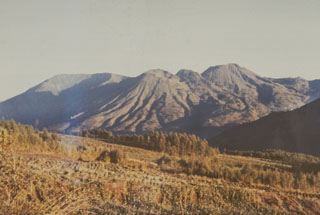Report on Dieng Volcanic Complex (Indonesia) — 11 January-17 January 2023
Smithsonian Institution / US Geological Survey
Weekly Volcanic Activity Report, 11 January-17 January 2023
Managing Editor: Sally Sennert.
Please cite this report as:
Global Volcanism Program, 2023. Report on Dieng Volcanic Complex (Indonesia) (Sennert, S, ed.). Weekly Volcanic Activity Report, 11 January-17 January 2023. Smithsonian Institution and US Geological Survey.
Dieng Volcanic Complex
Indonesia
7.2°S, 109.879°E; summit elev. 2565 m
All times are local (unless otherwise noted)
PVMBG reported increasing activity at Dieng Volcanic Complex in a press release posted on 14 January. The number of deep volcanic earthquakes and local tectonic earthquakes had been increasing starting on 9 January. Carbon dioxide gas concentrations at Timbang Crater also intensified, averaging 0.09-0.11 percent during 1-13 January. Primary hazards at Dieng included phreatic eruptions at Sileri Crater and flows of carbon dioxide gas that can impact residents and tourists. Based on the data and potential hazards at the complex, PVMBG raised the Alert Level to 2 (on a scale of 1-4) and warned the public to stay 1 km away from Sileri Crater and to stay out of Timbang Crater, and to take caution when digging in the ground as gasses could be released.
At 2116 on 15 January carbon dioxide emissions significantly increased. The carbon dioxide gas concentration at 0027 on 16 January was 5,600 parts per million (ppm), rising to 7,300 ppm by 0130. The mobile instrument measuring the gas was located 170 m from the midpoint of Timbang Crater. At 0540 the gas concentration was as high as 10,000 ppm, measured from 130 m away from the crater’s midpoint. In a second press release, PVMBG warned the public to stay 500 m away from the SE, S, and SW sectors of Timbang Crater.
Geological Summary. The Dieng plateau in the highlands of central Java is renowned both for the variety of its volcanic scenery and as a sacred area housing Java's oldest Hindu temples, dating back to the 9th century CE. The Dieng Volcanic Complex consists of multiple stratovolcanoes and more than 20 small Pleistocene-to-Holocene craters and cones over a 6 x 14 km area. Prahu stratovolcano was truncated by a large Pleistocene caldera, which was subsequently filled by a series of cones, lava domes, and craters, many containing lakes. Lava flows cover much of the plateau, but observed activity has been restricted to minor phreatic eruptions. Gas emissions are a hazard at several craters and have caused fatalities. There are abundant thermal features and high heat flow across the area.
Source: Pusat Vulkanologi dan Mitigasi Bencana Geologi (PVMBG, also known as CVGHM)

